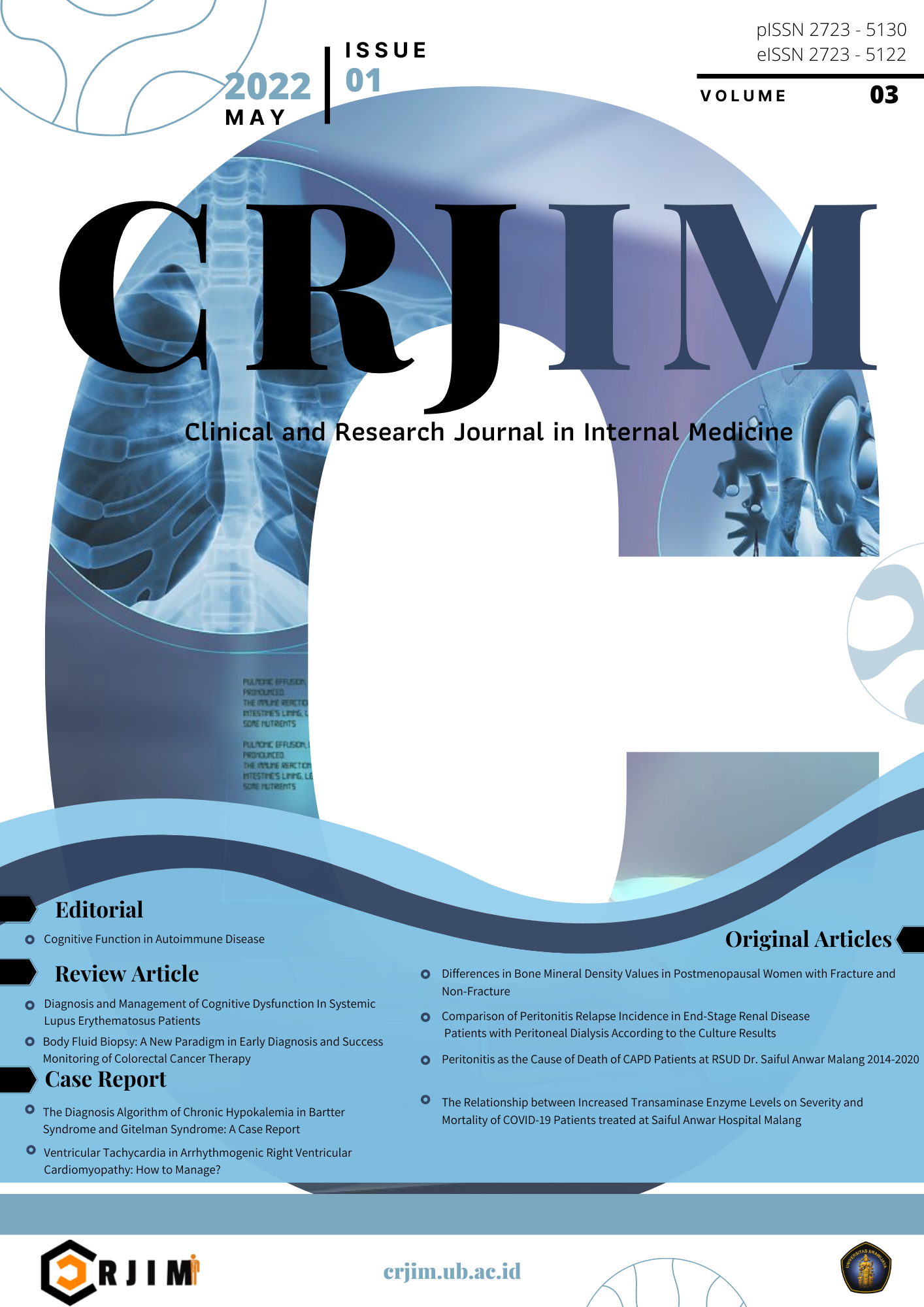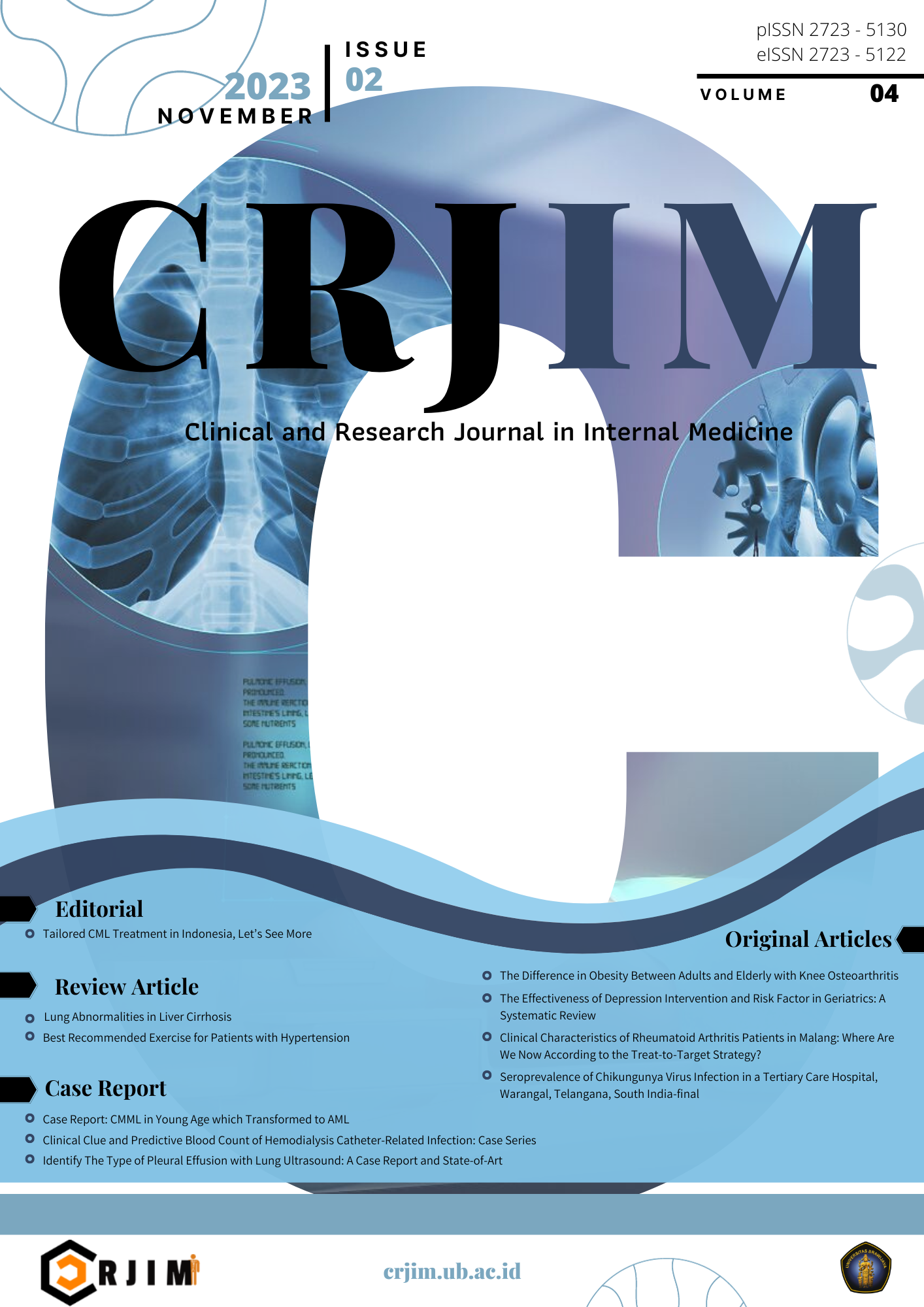Differences in Bone Mineral Density Values in Postmenopausal Women with Fracture and Non-Fracture
DOI:
https://doi.org/10.21776/ub.crjim.2022.003.01.2Keywords:
Osteoporosis, Post-menopause, BMD, FractureAbstract
Background: Osteoporosis is an increasing health problem in Indonesia. Fractures that occur in the spine and pelvis are considered to be the most common fracture sites for osteoporosis.
Aim: to determine the differences in bone mineral density values in postmenopausal women with fracture and non-fracture.
Methods: Survey was carried out in postmenopausal female patients with fractures and without fractures who were included in the inclusion criteria with a case-control study approach and had bone mass density data. For the group of cases with fracture, the amount of vertebral compression was measured using Gennant's measurement criteria. Interviews were conducted regarding the characteristics of patients with and without fracture. The differences in BMD values were analyzed in postmenpausal female patients with fracture and without fracture by using unpaired T test on normal data distribution and Mann-Whitney test on abnormal data distribution. The measured BMD value is the T-score. The analysis result was considered significant if p <0.05.
Results: There was a significant difference between L4 BMD (p = 0.029) and femoral neck BMD (p = 0.014) in postmenopausal female patients with fracture and without fracture. However, there were no significant differences for other BMD regions (p> 0.5).
Conclusion: BMD L4 and femoral neck values differ significantly in female patients with postmenopausal osteopenia with fracture and non-fracture.
References
Kementerian Kesehatan R. Infodati Kementerian Kesehatan, R., Infodatin pusat data dan informasi kementerian kesehatan RI. Situasi Gangguan Penglihatan dan Kebutaan. Jakarta Selatan, 2015.
Mithal A, Bansal B, Kyer CS, et al. The Asia-Pacific Regional Audit-Epidemiology, Costs, and Burden of Osteoporosis in India 2013: A report of International Osteoporosis Foundation. Indian J Endocrinol Metab. 2014 Jul;18(4):449-54.
[doi: 10.4103/2230-8210.137485]
Karaguzel G, Holick MF. Diagnosis and treatment of osteopenia. Rev Endocr Metab Disord. 2010 Dec;11(4):237-51.
[doi: 10.1007/s11154-010-9154-0]
Lin X., Xiong D., Peng YQ., et al. Epidemiology and management of osteoporosis in the People's Republic of China: current perspectives. Clin Interv Aging.,2015. 10, 1017–1033.
[doi: 10.2147/CIA.S54613]
Barry P., Aspray T., Briers K., et al. Osteoporosis: assessing the risk of fragility fracture. NICE Guideline : Draft for Consultation ;2012. 1-12.
United Nations. Policy Brief: The Impact of COVID-19 on older persons. Available at https://unsdg.un.org/siteup toefault/files/2020-05/Policy-Brief-The-Impact-of-COVID-19-on-Older-Persons.pdf. 2020.
Denson AC, Mahipal A. Participation of the elderly population in clinical trials: barriers and solutions. Cancer Control. 2014 Jul;21(3):209-14.
[doi: 10.1177/107327481402100305]
Boschitsch EP, Durchschlag E, Dimai HP. Age-related prevalence of osteoporosis and fragility fractures: real-world data from an Austrian Menopause and Osteoporosis Clinic. Climacteric. 2017 Apr;20(2):157-163. [doi: 10.1080/13697137.2017.1282452]
Svejme O, Ahlborg HG, Nilsson JÅ, et al. Early menopause and risk of osteoporosis, fracture and mortality: a 34-year prospective observational study in 390 women. BJOG. 2012 Jun;119(7):810-6.
[doi: 10.1111/j.1471-0528.2012.03324.x]
Nik Mohd Hatta NNK, Lokman M, Said N M, et al. Fracture risk prediction in post-menopausal women with osteopenia and osteoporosis: preliminary findings. Enferm Clin. 2018 Feb;28 Suppl 1:232-235. English, Spanish.
[doi: 10.1016/S1130-8621(18)30074-3]
Poiana C, Carsote M, Radoi V, et al. Prevalent osteoporotic fractures in 622 obese and non- obese menopausal women. J Med Life. 2015 Oct-Dec;8(4):462-6.
[PMID: 26664471; PMCID: PMC4656953]
Kendler DL, Bauer DC, Davison KS, et al. Vertebral Fractures: Clinical Importance and Management. Am J Med. 2016 Feb;129(2):221.e1-10.
[doi: 10.1016/j.amjmed.2015.09.020]
Waterloo S, Ahmed LA, Center JR, et al. Prevalence of vertebral fractures in women and men in the population-based Tromsø Study. BMC Musculoskelet Disord. 2012 Jan 17;13:3. [doi: 10.1186/1471-2474-13-3]
Bouxsein ML, Eastell R, Lui LY, et al. Change in Bone Density and Reduction in Fracture Risk: A Meta-Regression of Published Trials. J Bone Miner Res. 2019 Apr;34(4):632-642.
[doi: 10.1002/jbmr.3641]
Chen H, Zhou X, Fujita H, et al. Age-related changes in trabecular and cortical bone microstructure. Int J Endocrinol. 2013;2013:213234.
[doi: 10.1155/2013/213234]
Heidari, B, Hoshamand S, Hajian K, et al. Comparing bone mineral density in postmenopausal women with and without vertebral fracture and its value in recognizing high-risk individuals. East Mediterr Health J.; 2010. 16(8); 868-876
[doi: 10.4103/ijpvm.IJPVM_234_16]
Finkelstein JS, Brockwell SE, Mehta V, et al. Bone mineral density changes during the menopause transition in a multiethnic cohort of women. J Clin Endocrinol Metab. 2008 Mar;93(3):861-8. [doi: 10.1210/jc.2007-1876]
Johansson L., Sundh D., Zoulakis M., et al. The Prevalence of Vertebral Fractures Is Associated With Reduced Hip Bone Density and Inferior Peripheral Appendicular Volumetric Bone Density and Structure in Older Women. J Bone Miner Res.; 2018. 33(2):250-260.
[doi: https://doi.org/10.1002/jbmr.3297]
Choe HS, Lee JH, Min DK, et al. Comparison of vertebral and femoral bone mineral density in adult females. J Phys Ther Sci. 2016 Jun;28(6):1928-31.
[doi: 10.1589/jpts.28.1928]
Hunt HB, Donnelly E. Bone quality assessment techniques: geometric, compositional, and mechanical characterization from macroscale to nanoscale. Clin Rev Bone Miner Metab. 2016 Sep;14(3):133-149.
[doi: 10.1007/s12018-016-9222-4]
Fonseca H, Moreira-Gonçalves D, Coriolano HJ, et al. Bone quality: the determinants of bone strength and fragility. Sports Med. 2014 Jan;44(1):37-53.
[doi: 10.1007/s40279-013-0100-7. PMID: 24092631]

Downloads
Published
How to Cite
Issue
Section
License
Copyright (c) 2022 Clinical and Research Journal in Internal Medicine

This work is licensed under a Creative Commons Attribution 4.0 International License.
The copyright of the received article shall be assigned to the journal as the publisher of the journal. The intended copyright includes the right to publish the article in various forms (including reprints). The journal maintains the publishing rights to the published articles.

















